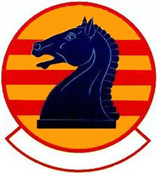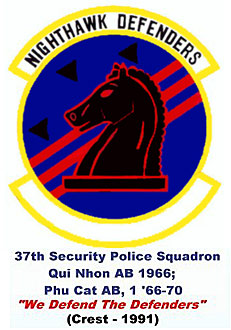37th Security Police Squadron (AETC)
LINEAGE.
- Constituted 37th Air Police Squadron, on 3 Mar 1953.
- Activated on 8 Apr 1953.
- Inactivated on 25 Jun 1953. Activated on 15 Oct 1985.
- Activated on 21 Feb 1966.
- Organized on 8 Mar 1966.
- Redesignated 37th Security Police Squadron on 15 May 1967.
- Inactivated on 31 Mar 1970.
- Activated on 5 Oct 1989.
- Inactivated on 8 Jul 1992. Activated on 15 Oct 1985.
- Activated on 1 Jul 1993.
ASSIGNMENTS.
- 37th Air Base Group, 8 Apr-25Jun 1953;
- Pacific Air Forces, 21 Feb 1966;
- 37th Combat Support Group, 8 Mar 1966-31 Mar 1970;
- 37th Combat Support Group, 5 Oct 1989-8 Jul 1992;
- 37th Support Group,1 Jul 1993--
STATIONS.
- Clovis AFB, NM, 8 Apr-25 Jun 1953.
- Qui Nhơn Afld, South Vietnam, 8 Mar 1966;
- Phu Cat AB, South Vietnam,
c.1 Aug 1966-31 Mar 1970;
- Tonopah Test Range, Nev, 5 Oct 1989-8 Jul 1992;
- Lackland AFB, TX, 1 Jul 1993---
HONORS.
VIETNAM WAR
SERVICE STREAMERS. None.
The Vietnam Service Streamer, a unit award analogous to the award of the medal and ribbon for the individual. is identical to the ribbon in design and color. A United States Air Force (USAF) unit qualified for the Vietnam Service Streamer if it was based in South Vietnam at any time between 1 July 1958 and 14 November, or 29 January through 28 March 1973. A unit based during these same periods in Thailand and flying missions into or over Vietnam also received the Vietnam Service Streamer. Nonpaying combat support units based in Thailand at any time between 1 July 1958 and 28 March 1973 are also entitled to the service streamer.
CAMPAIGN STREAMERS. Nine campaign streamers and five decorations.
A Campaign Streamer is a Vietnam Service Streamer with the name and dates of the campaign embroidered on it. With one exception, the Vietnam Air-Ground Campaign, a unit qualified for a campaign streamer if it was based in Vietnam or engaged in combat in Southeast Asia during the period of a designated campaign.["Current issue battle streamer as used on US military flags. Overall length 49" embroidered in white on the color of the "Vietnam Service" medal ribbon. This practice dates from June 1920 as prescribed by the Secretary of War and continues to this day." ]
Qui Nhơn Air Field, South Vietnam, 8 Mar-Aug 1, 1966:
- Vietnam Air, 31 January - June 1966.

- Vietnam Air Offensive, 29 June 1966-8 March 1967.

Phu Cat Air Base, South Vietnam,
1 Aug 1966- 31 Mar 1970:
- Vietnam Air Offensive, Phase II, 9 March 1967-31 March 1968.

- Vietnam Air/Ground, 22 January-7 July 1968.

- Vietnam Air Offensive, Phase III, 1 April-October 1968.

- Vietnam Air Offensive, Phase IV, 1 November 1968-22 February 1969.

- TET 69/Counteroffensive, 23 February-8 June 1969.

- Vietnam Summer-Fall, 9 June-31 October 1969.

- Vietnam Winter-Spring, 1 November 1969-30 April 1970.

ARMED FORCES EXPEDITIONARY STREAMERS. None.
DECORATIONS.
- Presidential Unit Citation: Southeast Asia, 1 Jul-31 Dec 1968.

Air Force Outstanding Unit Awards with
Combat "V" Device
:
- 1 Jul 1966-30 Jun 1967;
- 1 Jul 1967-30 Jun 1968;
- 1 Apr 1969-31 Mar 1970.

AFOUA with "V" Nomination: 37th Security Police Squadron, with accomplishments: Phu Cat,
1 Apr 1969-31 Mar 1970:
- aa. (C) The 37th Security Police Squadron mortarmen developed and implemented a new technique in mortar gunnery--the use of "delayed illumination" mortar rounds as target markers for Air Force gunships. In addition, 37th Security Police Squadron personnel, trained as Forward Observers, controlled and exercised AC-47 Gunships of the 4th Special Operations Squadron using this technique during a local area harassment and interdiction program. On 5 May 1969, the 37th Security Police Squadron convened the first class of the 7th Air Focre Mortar School which was developed and centralized at Phu Cat Air Base. Since the Air Force experience with the 81mm mortar was substantially different from that of the U.S. Army, the 37th Security Police Squadron mortar cadre was required to prepare a curriculum for this school virtually from scratch. The development of the school, and preparations for its implementation, were conducted expeditiously and thoroughly. The majority of the actual mortar firing was accomplished at night as an integral phase of the harrassment and interdiction program, thus reducing ammunition costs. The overall excellence of the training provided by the school was recognized by the U.S. Army, Commanders of the 41st Artillery Group, 7/15 Artillery Battalion, and the Qui Nhơn Support Command requested school quotas for members of their commands. When the 52nd Artillery Group at Pleiku Air Base was forming its own weapons schook, the Commandat-Designate attended the 7th Air Force Mortar School for familiarization.
bb. (U) The Law Enforcement Section of the 37th Security Police Squadron assumed a sizeable task when the Qui Nhơn Army Air Field was closed for repairs on 15 June. Flying operations were transferred to Phu Cat Air Base, thereby vastly increasing the personnel and vehicular traffic on base. Extra posts were established at the main gate, passenger terminal, and a separate operating area established for Air VIetnam. Mortoized security patrols were extensively utilized to provide continuous escort for Vietnamese personnel and vehicles traveling between the main gate and the flight line. The extent of this operation is evidenced by the fact that this traffic often exceeded 100 vehicles per hour. Effective coordination with Base Operations permitted the escort of Air Vietnam passengers from the main gate to the flight line between the time their aircraft came into the landing pattern and the time it shutdown its engines. When Qui Nhơn Army Air Field resumed operations on 31 August, traffic returned to normal.
cc. (U) From April through 31 December 1969, a comprehensive integration of new weapons and tactics was established which included the introduction of six new armored personnel carriers equiped with .50 calibre machine guns. The M-174 Automatic Grenade Launcher was introduced into the base defense inventory, and within three weeks of the arrival of the weapon, every member of the 37th Security Police Squadron was qualified in its use. From April through August 1969, members of the 37th Security Police Squadron Intelligence Branch flew twice-daily reconnaissance missions, covering the local Phu Cat area, on board HH-43 helicopters of the 38th Aerospace Rescue and Recovery Squadron. These flights, curtailed in August 1969, were resumed in December, utilizing O-1 aircraft of the 21st Tactical Air Support Squadron.
dd. (C) On 17 November 1969, a 37th Security Police Squadron security force team sighted four intruders who had penetrated the Air Base perimeter. During the encounter, three of the intruders were killed, while the fourth was wounded and later apprehended. Once again, the Air Base sustained no damage.
ee. (C) Throughtou the spring and summer of 1969, the 37th Security Police Squadron team prepared for the field testing of a prototype electronic detection and surveillance system in conjunction with the 485th Ground Electronics Engineering Installation Agency (GEEIA), Air Force Logistics Command, and the Aerospace Systems Division of the Air Force Systems Command. This project which bore the code name Safe Look, consisted of field testing the Westinghouse Balance Pressure System and the Honeywell Multi-Concealed Instrumentation Detection System. In addition, two other systems were tested by the Safe Look Force: the million-candlepower "Big Light" developed by the Advanced Research Projects Agnecy, Office of the Secretary of Defense, and the SADS 1.5 point-detection system. Data resulting from these initial field tests will inform Air Force Systems Command of Future revisions required for these systems. For its major part in these important tests, the 37th Security Police Squadron received commednation from the Safe Look Project Officer.
ff. (U) On 17 November 1969, the first Correctional Custody Facility in 7th AIr Force was opened under the supervision of the 37th Security Police Squadron. Utilizing a living area vacated by a small U.S. Army unit, the Law Enforcement Section exercised control over the facility and a program designed to enhance discipline and effect proper military attitude. The 7th Air Force Inspector General Report highlighted this commendable program, and stated, "Though recently implemented, beneficial results had already been achieved as reflected by a lowering of incident rate."
gg. (U) In December 1969, the 37th Security Police Squadron could review the following accomplishments since 1 April 1969: two penetrations of the installation halted at the perimeter fenceline, four intruders KIA, one intruder wounded and apprehended, six guard towers, 12 bunkers, 9.2 miles of fence, 130 perimeter lights, 42 K-9 fighting positions, 27 tower fighting walls, and four mortar gunnery and 116 students certified in fire direction at the 7th Air Force Mortar School; and the first Correctional Custody Facility in 7th Air Force. In addition, the Administrative Security and Intelligence branches of the squadron received "Outstanding" ratings from the 7th Air Force Inspector General.
Republic of Vietnam Gallantry Crosses with Palm:
- 1 Apr 1966-31 Mar 1970.

EMBLEM.  
37th Security Police Sq
UNIT EMBLEM (1970): 37th Security Police Squadron
Approved 23 Mar 1970. Negative Number: KE-36019.
DESCRIPTION:
On a yellow disc edged red, three red bars throughout in fess surmounted by a blue chess knight. Attached below the disc a blank white scroll edged red.
SIGNIFICANCE:
The emblem is symbolic of the squadron, and the Air Force colors, ultramarine blue and golden yellow, are used in the design. The color blue alludes to the sky, the primary theater of Air Force operations, and yellow to the sun and excellence of personnel in assigned duties. The background of the disc and horizontal bars are symbolic of the unit's service in Southeast Asia. The chess knight, the most maneuverable of pieces in the historic game, suggests the maneuverability and quick response of security forces to threats against the resources of the installation.
MOTTO: WE DEFEND THE DEFENDERS, alludes to the motto to the 37th TFW--"Defenders of the Crossroads".
CABLE NUMBERS OF COLORS:
|
|
| Red
| 70042
|
|
| White
| 67101
|
|
| Air Force Yellow
| 67103
|
|
| AF Ultramarine Blue
| 67118
|
|
UNIT EMBLEM (1991-Current): 37th Security Police Squadron
EMBLEM.  
37th Security Police Sq.,
Approved DFSC 91-02967.
DESCRIPTION:
On a blue disc edged in gold, three red bars throughout surmounted by a black chess knight and three black darts. Attached below the disc is a white scroll edged in gold with gold lettering.
SIGNIFICANCE:
The emblem is symbolic of the squadron's, mission and history. The ultramarine blue background alludes to the sky, the primary theater of Air Force operations. The three red bars are symbolic of the unit's service in South Vietnam. The three black darts represent the Stealth Fighters of the three tactical fighter squadrons of the 37th Tactical Fighter Wing the squadron is tasked to defend. The black chess knight, the most maneuverable of pieces in the historic game, suggests the maneuverability of the unit to deploy anywhere with the aircraft and the quick response of security forces to any threat against wing resources during daylight or darkness.
MOTTO: NIGHTHAWK DEFENDERS.
CABLE NUMBERS OF COLORS:
|
|
| Red
| 70042
|
|
| White
| 67101
|
|
| Air Force Yellow
| 67103
|
|
| AF Ultramarine Blue
| 67118
|
|
DATE PREPARED. 25 Sep 1996.
SUPERSEDES. Statement prepaped on 3 Oct 1989.
PREPARED by Helen Weaver.
|